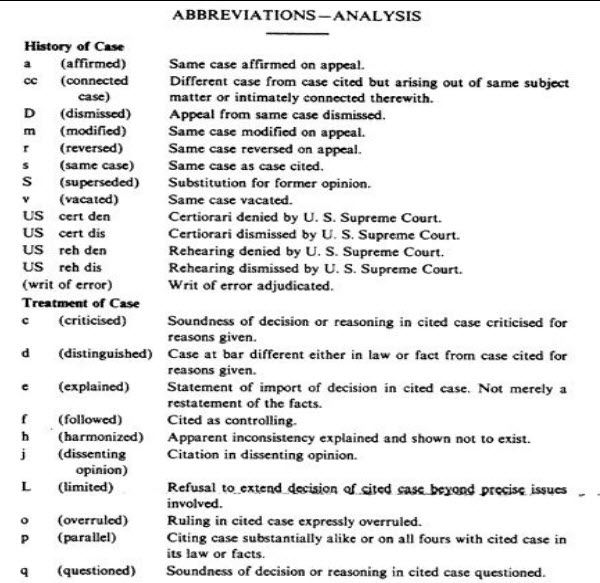Great places to begin or expand your research
 |
|
Shepard's has three main functions: 1. VALIDATES 2. PROVIDES 3. ACTS AS A CASE
|
|
Validating Authority Above we are Shepardizing a case titled Jones v. Barnes. But what we really care about is the volume, publication and page number because the contents of Shepard's is not organized by case title. Instead, it is organized by volume number, publication, and page number. This is because you really Shepardize a publication as much as you Shepardize a case. The cite is: 318 S.E.2d 164 1. LOCATE In this case, our citation is from the South Eastern Reporter. Thus we need to find the set of Shepard's titled Shepard's South Eastern Reporter Citations. 2. LOCATE THE
|
|
|
3. LOCATE THE PAGE
IN SHEPARD'S
COVERING THE
VOLUME 4. LOCATE THE PAGE
NUMBER FROM
THE CITATION Now, at this point you are probably wondering what the heck that abbreviation is. In fact, what the heck are ALL those abbreviations in Shepard's. The bad news is that Shepard's has created its own little world of citation form. It's not Blue Book, that's for sure! The good news is that every single volume of Shepard's has a Table of Abbreviations that will decipher the abbreviations for you. Don't get frustrated. Just accept it. Now, it's usually not hard to figure out what the abbreviation refers to. Here we have "GaA." This stands for the Georgia Appellate Reports. If it had just been "Ga," it would have represented the Georgia Reports. Not too hard, huh? But you must remember that this citation must be modified to correct BLUEBOOK FORM if you decide to cite it! The correct Blue Book abbreviation for "GaA" would be: Ga. App.
VALIDATING THE CASE The first cases Shepard's will list are any HISTORY cases that exist. History cases are the same case (Jones v. Barnes) at an earlier or subsequent level of litigation. For instance, if Jones v. Barnes was later appealed, that citation would appear as a history cite. Once again, if there are any history cases, they will be listed first. After any history citations, Shepard's will provide any TREATMENT citations. Treatment cases are those cases that have actually referred to the cited case. Not the same parties, but a totally different legal matter that cited the "Cited" case. Notice the abbreviations on the left hand side of the citations, such as a small f, e, h, r, etc. These are HISTORY and TREATMENT notations. They inform the researcher of the manner in which the citing case has dealt with the cited case. For instance, if the one of the CITING authorities has an "f" next to it, this indicates that the CITING case "followed" the legal logic of the CITED case (the case being Shepardized). If, however, the abbreviation was an "r," this would indicate that the CITING case reversed the decision in the CITED case. To view the list of abbreviations, click on ABBREVIATIONS above. To return to this page, click on VALIDATE. For the case we are Shepardizing, there are no History notations. They would have been listed first. There are, however, several Treatment notations. How many can you count? According to this Shepard's page, is this case still valid? (Answers are provided below.) After referring to the Abbreviation page, you should be have been able to determine that there were 5 Treatment notations. They all "followed" the cited authority. Therefore, this case is still valid. ZOOM in around the page. Notice the other abbreviations. Look for some History notations, as well as Treatment notations. For instance, look at page 144. That case is Martin v. Sears Roebuck and Company. Is it still valid? No. It was both reversed and vacated by later, citing authority. This is how Shepard's validates authority.
|
|
MORE . . . Notice the image above. This image demonstrates every step of the Shepardizing process. Starting in the top, left hand corner, and moving counter-clockwise: THE AUTHORITY SHEPARD'S MAIN VOLUME HARD BOUND SUPPLEMENTS SOFT BOUND SUPPLEMENTS It should be noted that once in a while, there may be no soft bound supplement. This only happens when Shepard's sends out a brand new hard bound volume that consolidates the information contained in the previous soft bound supplements. For a short period, this new hard bound supplement is the most recent supplement available. For a quick visual review of the Shepard's process, click on the volumes below, from left to right. You may notice that in at least one of the supplements, there is no page number corresponding to your page "164." You needed be concerned that you have made a mistake. If a Shepard's supplement does not provide the page to your cited case, this simply indicates that no further authorities have cited the case. It basically has no effect on the validity of the case.
|

